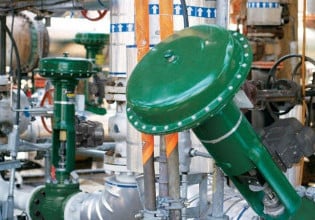Battery Storage Breaks Records
The American Clean Power Association recently unveiled its fourth-quarter and full-year market report with interesting findings about clean energy deployment in the United States. Let’s unpack.
New data from the American Clean Power Association (ACP), a Washington, D.C.-based trade group with more than 1,000 member companies, shows that 2022 was a banner year for new grid-scale battery storage projects—charting an 80% increase in cumulative capacity to 9 gigawatts (GW) and 25 gigawatt-hours (GWh). Developers commissioned 4 GW of new energy storage projects last year, outshining 2021’s total of 3 GW.

The 50 MW Byrd Ranch Storage facility in Sweeny, Texas, was the largest standalone storage project to come online in Q4 2022, according to the American Clean Power Association. Image used courtesy of GlidePath
Overall, clean energy installations jumped significantly in the fourth quarter, with utilities adding 9.6 GW of solar, wind, and storage capacity through 131 projects spanning 36 states. Zooming out, though: That number represents the lowest quarterly installations since 2019 and a 21% drop from 2021.
And despite new investments from utilities and companies looking to capitalize on incentives in the Inflation Reduction Act (IRA), annual installations fell behind the last two years of traction. Developers added 25.1 GW across 451 projects in almost every state, representing $35 billion in capital investments. But that’s still a 16% drop from record-breaking totals in 2021 and -12% from 2020.

The American Clean Power Association’s fourth-quarter 2022 Clean Power Quarterly Report shows a drop in renewable energy installations. Image used courtesy of ACP
ACP attributes the overall decline to a combination of supply chain issues, interconnection delays, lack of clarity in trade policy, uncertainty around IRA implementation, and permitting barriers.
Battery Storage Breaks Records in 2022
Cumulative battery storage capacity jumped 80% in 2022, while storage energy capacity grew 93%. The year saw 88 battery storage projects come online, of which 40 are standalone projects, and 48 are paired with solar and wind.
The largest battery storage project commissioned in 2022 is California’s 350 MW/1.4 GWh Crimson Storage facility.

Annual and cumulative utility-scale battery storage capacity additions. Image used courtesy of ACP
Meanwhile, 5.8 GW of hybrid power capacity was added in 2022, with 88% being solar + storage capacity. That brings the total to 12.8 GW of hybrid projects fully operational in the U.S. Another 6.5 GW of hybrid storage is partially online, and 31 GW is in the pipeline.
Solar and Land-based Wind Projects
While America’s battery storage market closed 2022 with record installations, solar led the pack in capacity, topping 12.6 GW. Nearly 5 GW of that capacity came online in the fourth quarter, as solar outpaced wind and storage in quarterly installations. However, this is short of 2021’s totals and far behind the 30% growth forecasted by WoodMackenzie and BloombergNEF, as cited in ACP’s report. (WoodMackenzie expects the solar market to bounce back in 2023 with an 84% jump in utility-scale installations amid IRA-fueled demand and easing supply chain constraints.)
According to ACP, solar’s decline is partially tied to recent challenges in sourcing solar panels due to trade restrictions. This is also mainly why solar accounts for nearly two-thirds of delayed clean energy capacity.
Lengthy interconnection queues are another factor, with solar accounting for much of the capacity that awaits connection to the grid. Uncertainty also played a role as the solar industry awaited guidance from the U.S. Internal Revenue Service and the Department of Treasury on requirements to qualify for the IRA’s tax credits.

Amount of capacity currently in interconnection queues. Image used courtesy of American Clean Power Association
Meanwhile, land-based wind projects closed the year with a strong quarter of 4 GW of projects commissioned. Still, the total 8.5 GW installed last year reflects a 37% drop from 2021 and the lowest year since 2018. The ACP cites the declining value of the Production Tax Credit for wind projects and uncertainty around the phase-down schedule.
Overall, wind installations slowed in 2022 as nearly 11 GW of land-based capacity was delayed due to supply and grid interconnection issues.

Annual and cumulative land-based wind capacity additions. Image used courtesy of the American Clean Power Association
Clean Energy Development Pipeline
The ACP says 227 GW of clean energy capacity is currently operating in the U.S.—enough for 61 million homes. Consistent with market demand, the U.S.’s clean energy development pipeline reached a new high in 2022, growing 13% since the end of 2021.
The fourth quarter saw 9.5 GW of projects start construction and another 8.2 GW enter advanced development. This brings the near-term development pipeline to 1,120 project phases totaling 135 GW of capacity, with 42 GW under construction and 93 GW in advanced development.

Renewable energy projects in the development pipeline across the U.S. Image used courtesy of American Clean Power Association
Solar accounts for the largest share of upcoming projects, with 59% of capacity. The land-based wind sector followed with 15%, then offshore with 13%, and battery storage with 12%.






